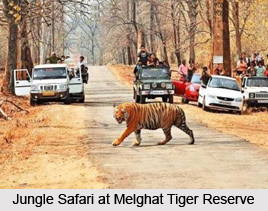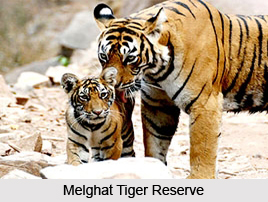 Melghat Tiger Reserve, as the name suggests, the landscape, which is formed, is actually a conglomeration of hills, with interconnected mountainous ranges. Also Gugamal National Park is a part of the reserve. Several ravines, better known as khoras intercept the hills. For the scenic beauty, Bairat, Chilati and Bhoot Khoras are renowned. Within the locale, a pleasing small hill city of Chikhaldara has been formed in the British colonial period and also a top Vairat (1,178 m) are formed. Melghat itself has a treasure of parched deciduous forests of teak and bamboo with a handful of semi evergreen trees alongside the banks of streams.
Melghat Tiger Reserve, as the name suggests, the landscape, which is formed, is actually a conglomeration of hills, with interconnected mountainous ranges. Also Gugamal National Park is a part of the reserve. Several ravines, better known as khoras intercept the hills. For the scenic beauty, Bairat, Chilati and Bhoot Khoras are renowned. Within the locale, a pleasing small hill city of Chikhaldara has been formed in the British colonial period and also a top Vairat (1,178 m) are formed. Melghat itself has a treasure of parched deciduous forests of teak and bamboo with a handful of semi evergreen trees alongside the banks of streams.
The forests of Melghat are vital catchments locale for the large, drought prone stretch of central India. The Tapti River forms the northern border of the Melghat Tiger Reserve and a network of streams flows through the rocky landscapes. However, the reserve has become a victim of urban population. To fulfill their own demands, they dig up water holes, thereby raising the groundwater level. Tiny earthen dams have been constructed to put in store water for the lengthy, sultry summer months.
The best time to make a visit to the Melghat Tiger Reserve is the summer months. At that time one can catch a glance of wild animals roam around at ease.
 Due to scanty growth of plants, they are also easily visible to the tourists, who throng the place in great enthusiasm. Scattered herds of Gaur are a familiar sight. They are referred as the Indian Bison; this huge ox basically resides in a hill, even though it often comes down in search of its prey in the meadows. Quite a few other animals are also seen in Melghat Tiger Reserve. Tigers are seen occasionally, though one can also see a leopard or a sloth bear in some nook of the reserve. Grey Junglcfowl and other woodland birds abound in the park. Towards the end of May, the singing of the Indian Pitta echoes across the arid forests. Frequent visits to Koktoo and Semadoh, prime Gaur and Tiger habitats, extend the most excellent opportunities for flora and fauna to be viewed. Other mammalian species are Leopard, Wild Dog (Dhole), Jungle Cat, Common Palm Civet, Jackal, Striped Hyena, Sambar, Spotted Deer (Chital), Barking Deer, Mouse Deer, Chowsingha (Four-horned Antelope), Nilgai (Blue Bull), Indian Pangolin, and Indian Porcupine etc.
Chirping of birds is a special attraction among the tourists in the Melghat Tiger Reserve. Woodland birds include Grey jungle fowl, Indian Peafowl, Grey Francolin, Painted Francolin, Red Spurfowl, Greater Racket-tailed Drongo, White-bellied Drongo, Indian Grey Hornbill, White-naped Woodpecker, Chestnut-bellied Nuthatch, Indian Pitta, Emerald Dove and Oriental Turtle Dove. Also Sirkeer Malkoha, Malabar Whistling Thrush, Orange-headed Thrush, Indian Scimitar Babbler, Black-hooded Oriole, Large Cuckoo shrike, Scarlet Minivet, Verditer Flycatcher, Asian Paradise-flycatcher, Crested Bunting are frequently seen. Hunting birds too throng the place these are namely crested serpent Eagle, Oriental Honey-buzzard, Eurasian Hobby, Bonelli`s Eagle, Mottled Wood Owl, Jungle Owlet.
Due to scanty growth of plants, they are also easily visible to the tourists, who throng the place in great enthusiasm. Scattered herds of Gaur are a familiar sight. They are referred as the Indian Bison; this huge ox basically resides in a hill, even though it often comes down in search of its prey in the meadows. Quite a few other animals are also seen in Melghat Tiger Reserve. Tigers are seen occasionally, though one can also see a leopard or a sloth bear in some nook of the reserve. Grey Junglcfowl and other woodland birds abound in the park. Towards the end of May, the singing of the Indian Pitta echoes across the arid forests. Frequent visits to Koktoo and Semadoh, prime Gaur and Tiger habitats, extend the most excellent opportunities for flora and fauna to be viewed. Other mammalian species are Leopard, Wild Dog (Dhole), Jungle Cat, Common Palm Civet, Jackal, Striped Hyena, Sambar, Spotted Deer (Chital), Barking Deer, Mouse Deer, Chowsingha (Four-horned Antelope), Nilgai (Blue Bull), Indian Pangolin, and Indian Porcupine etc.
Chirping of birds is a special attraction among the tourists in the Melghat Tiger Reserve. Woodland birds include Grey jungle fowl, Indian Peafowl, Grey Francolin, Painted Francolin, Red Spurfowl, Greater Racket-tailed Drongo, White-bellied Drongo, Indian Grey Hornbill, White-naped Woodpecker, Chestnut-bellied Nuthatch, Indian Pitta, Emerald Dove and Oriental Turtle Dove. Also Sirkeer Malkoha, Malabar Whistling Thrush, Orange-headed Thrush, Indian Scimitar Babbler, Black-hooded Oriole, Large Cuckoo shrike, Scarlet Minivet, Verditer Flycatcher, Asian Paradise-flycatcher, Crested Bunting are frequently seen. Hunting birds too throng the place these are namely crested serpent Eagle, Oriental Honey-buzzard, Eurasian Hobby, Bonelli`s Eagle, Mottled Wood Owl, Jungle Owlet.
To be in same pace with other reserves, Melghat Tiger Reserve too is fascinated in upholding the grand project of preserving its beauty and glory. Serious threats like the forest fires, water scarcity, rampant exploits of timber and developmental projects are being checked to the utmost extent.











